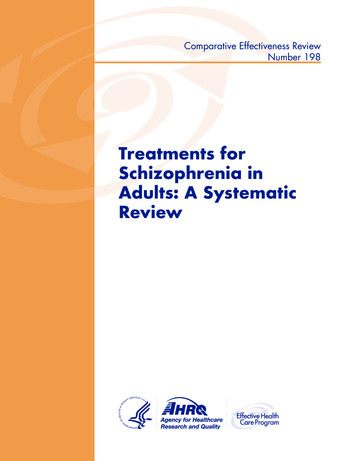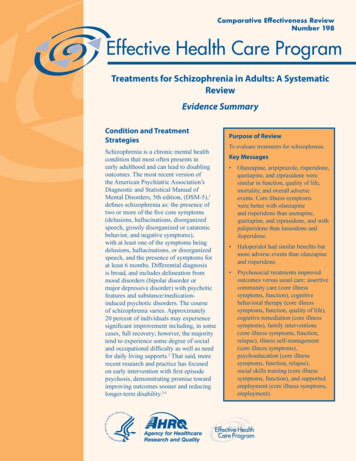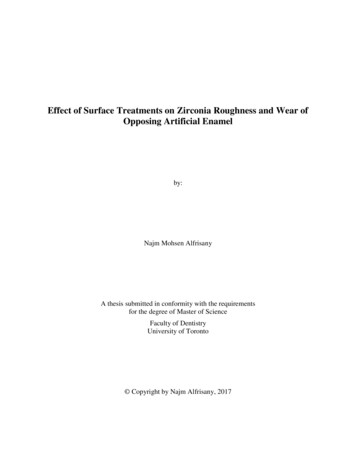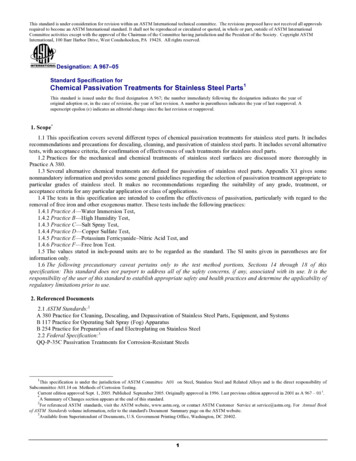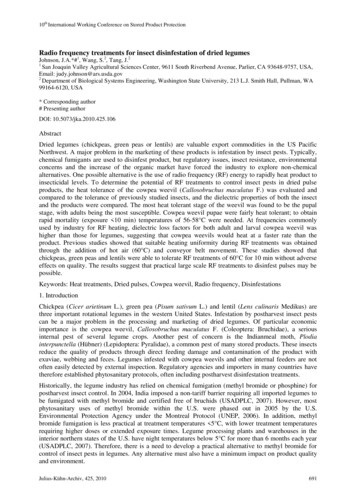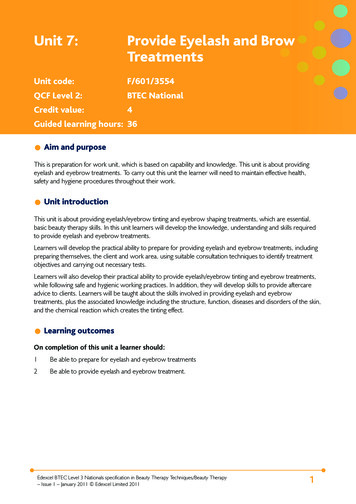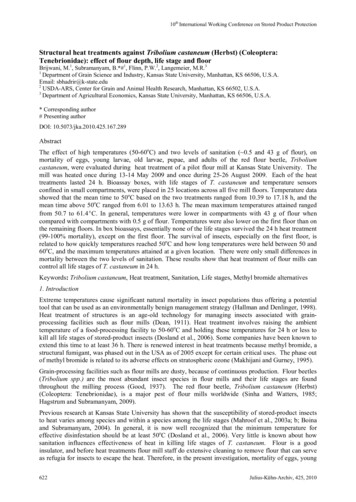
Transcription
10th International Working Conference on Stored Product ProtectionStructural heat treatments against Tribolium castaneum (Herbst) (Coleoptera:Tenebrionidae): effect of flour depth, life stage and floorBrijwani, M.1, Subramanyam, B.*#1, Flinn, P.W.2, Langemeier, M.R.31Department of Grain Science and Industry, Kansas State University, Manhattan, KS 66506, U.S.A.Email: sbhadrir@k-state.edu2USDA-ARS, Center for Grain and Animal Health Research, Manhattan, KS 66502, U.S.A.3Department of Agricultural Economics, Kansas State University, Manhattan, KS 66506, U.S.A.* Corresponding author# Presenting authorDOI: 10.5073/jka.2010.425.167.289AbstractThe effect of high temperatures (50-60oC) and two levels of sanitation ( 0.5 and 43 g of flour), onmortality of eggs, young larvae, old larvae, pupae, and adults of the red flour beetle, Triboliumcastaneum, were evaluated during heat treatment of a pilot flour mill at Kansas State University. Themill was heated once during 13-14 May 2009 and once during 25-26 August 2009. Each of the heattreatments lasted 24 h. Bioassay boxes, with life stages of T. castaneum and temperature sensorsconfined in small compartments, were placed in 25 locations across all five mill floors. Temperature datashowed that the mean time to 50oC based on the two treatments ranged from 10.39 to 17.18 h, and themean time above 50oC ranged from 6.01 to 13.63 h. The mean maximum temperatures attained rangedfrom 50.7 to 61.4⁰C. In general, temperatures were lower in compartments with 43 g of flour whencompared with compartments with 0.5 g of flour. Temperatures were also lower on the first floor than onthe remaining floors. In box bioassays, essentially none of the life stages survived the 24 h heat treatment(99-100% mortality), except on the first floor. The survival of insects, especially on the first floor, isrelated to how quickly temperatures reached 50oC and how long temperatures were held between 50 and60oC, and the maximum temperatures attained at a given location. There were only small differences inmortality between the two levels of sanitation. These results show that heat treatment of flour mills cancontrol all life stages of T. castaneum in 24 h.Keywords: Tribolium castaneum, Heat treatment, Sanitation, Life stages, Methyl bromide alternatives1. IntroductionExtreme temperatures cause significant natural mortality in insect populations thus offering a potentialtool that can be used as an environmentally benign management strategy (Hallman and Denlinger, 1998).Heat treatment of structures is an age-old technology for managing insects associated with grainprocessing facilities such as flour mills (Dean, 1911). Heat treatment involves raising the ambienttemperature of a food-processing facility to 50-60oC and holding these temperatures for 24 h or less tokill all life stages of stored-product insects (Dosland et al., 2006). Some companies have been known toextend this time to at least 36 h. There is renewed interest in heat treatments because methyl bromide, astructural fumigant, was phased out in the USA as of 2005 except for certain critical uses. The phase outof methyl bromide is related to its adverse effects on stratospheric ozone (Makhijani and Gurney, 1995).Grain-processing facilities such as flour mills are dusty, because of continuous production. Flour beetles(Tribolium spp.) are the most abundant insect species in flour mills and their life stages are foundthroughout the milling process (Good, 1937). The red flour beetle, Tribolium castaneum (Herbst)(Coleoptera: Tenebrionidae), is a major pest of flour mills worldwide (Sinha and Watters, 1985;Hagstrum and Subramanyam, 2009).Previous research at Kansas State University has shown that the susceptibility of stored-product insectsto heat varies among species and within a species among the life stages (Mahroof et al., 2003a; b; Boinaand Subramanyam, 2004). In general, it is now well recognized that the minimum temperature foreffective disinfestation should be at least 50oC (Dosland et al., 2006). Very little is known about howsanitation influences effectiveness of heat in killing life stages of T. castaneum. Flour is a goodinsulator, and before heat treatments flour mill staff do extensive cleaning to remove flour that can serveas refugia for insects to escape the heat. Therefore, in the present investigation, mortality of eggs, young622Julius-Kühn-Archiv, 425, 2010
10th International Working Conference on Stored Product Protectionlarvae, old larvae, pupae, and adults of T. castaneum during two heat treatments of a pilot flour mill wereevaluated. Additionally, during the heat treatment of the flour mill, the effect of different sanitationlevels on mortality of T. castaneum life stages was assessed.2. Materials and methods2.1. Pilot flour millThe Hal Ross Flour Mill of the Department of Grain Science and Industry, Kansas State University, is astate-of-the-art pilot scale mill. It has five floors and a capacity of 9626 m3. The mill is used for studentand faculty research and teaching, and occasionally for use by grain industry stakeholders.2.2. Box bioassaysCultures of T. castaneum were reared on wheat flour plus 5% (by wt) Brewer’s yeast diet at 28oC and65% r.h. Eggs, young larvae, old larvae, pupae, and unsexed adults of mixed ages were collected fromcultures following procedures described by Mahroof et al. (2003a;b). Each life stage was confined inplastic compartments inside a rectangular plastic box that was 27 cm long, 17.5 cm wide, and 4.2 cmhigh. There were a total of 12 small compartments within this box, and each compartment measured 8.3cm long, 4.2 cm wide, and 3.7 cm deep. The top row of the compartments had 2 cm deep flour (43g/compartment), and the bottom row had a dusting of flour ( 0.5 g/compartment). Ten of the 12compartments were used for confining insects and the other two were used for placing small sensors(SmartButton; ACR Systems Inc., Surrey, Canada) for measuring temperatures during heat treatment. Ineach compartment, 50 individuals of a life stage were introduced. Compartments with 0.5 g of flourrepresented or simulated “good” sanitation in food-processing facilities and the 43 g of flour simulated“poor” sanitation. Infested boxes were placed in 25 preselected mill locations. There were five boxes oneach floor. Boxes among floors were placed within equipment or on the floor. The control bioassay box,with all life stages of T. castaneum was placed in a growth chamber in the laboratory at 28oC and 65%r.h. There were four such control boxes. After 24 h of heat treatment, all bioassay boxes were broughtto the laboratory and incubated at 28oC and 65% r.h. The mortality of adults was measured 24 h afterincubation at 28oC and 65% r.h. Immature stages were reared until emergence of adults and the numberof adults counted.2.3. Mill heat treatmentThe structural heat treatments were conducted on 13-14 May 2009 and on 25-26 August 2009. Eachtreatment was performed for 24 h using forced-air gas heaters and the treatments were done by aprofessional heat treatment service provider (Temp-Air, Burnsville, MN, U.S.A.). Propane was used asthe fuel for the gas heaters. Uniform distribution of heat was ensured by placing 8 fans on each of thefive floors. The real-time temperature distribution during heat treatment within the mill was monitoredby the facilitator using Temp-Air wireless sensors, and these data are not reported here.Two SmartButton sensors were used in each bioassay box. One sensor was placed in a compartmentwith 0.5 g of flour and the other was used in the compartment with 43 g of flour. In compartments with43 g of flour, the sensor was placed at a depth of 1 cm. Sensors recorded temperature every 2 min duringa heat treatment. The 24 h time-dependent temperature profile for the two treatments was averaged bylocation and flour depth to determine time to reach 50oC, time above 50oC, and the maximumtemperature.2.4. Data analysisThe mean mortality data of T. castaneum life stages from the two treatments was subjected to factorialanalysis of variance (ANOVA) to determine differences among the main (stage, flour depth, and floor)and interactive effects using the GLM procedure of SAS (SAS Institute, 2002). The relationship betweenmean mortality of each life stage and time to 50oC, time above 50oC, and maximum temperature wasdetermined by subjecting data to the CORR procedure of SAS. All differences were consideredsignificant at the α 0.05 level.3. ResultsThe outside temperature during May and August within the bioassays ranged from 20.5 to 25.5oC and24.5 to 33.5oC, respectively. During the May treatment 5,306 L of propane was consumed, and the totalJulius-Kühn-Archiv, 425, 2010623
10th International Working Conference on Stored Product Protectionheat energy generated was 37,748 kW. During August treatment 4,889 L of propane was consumed, andthe total heat generated was 34,782 kW. The total heat energy per cubic meter of the mill space per hourduring the May and August treatment was 0.16 kW/m3/h and 0.15 kW/m3/h, respectively.The mean time to reach 50oC based on the two treatments ranged from 10.39 to 17.18 h (Table 1).Similarly, temperatures above 50oC were maintained for a mean time period of 6.01 to 13.63 h. Themean maximum temperatures attained ranged from 50.6 to 61.4⁰C. In general, the time to reach 50oCtook longer in compartments with 43 g of flour when compared with compartments with 0.5 g of flour(Fig. 1), whereas the time above 50oC and maximum temperatures attained were slightly lower incompartments with 43 g of flour when compared with compartments with 0.5 g of flour. Temperaturesin general were lower on the first floor than on the remaining floors above it.Table 1Summary of temperatures observed in bioassay boxes by mill floor based on May and August, 2009heat treatments of a small flour mill.0.5 g of flourFloorTime to50oC (h)Time above50oC urth12.5611.46Fifth12.0211.99Each mean is based on n 2 replications.Figure 143 g of flourMaximumtemp. (oC)Time to50oC (h)Time above50oC (h)Maximumtemp. 5Temperature profiles in compartments with 0.5 g and 43 g of flour. These data are from a bioassay boxplaced on the first floor of the mill during May heat treatment.The mean mortality of eggs in unheated compartments with 43 g of flour and 0.5 g of flour was 24 and57%, respectively. High mortality (37%) was also observed with young larvae in compartments with 0.5g of flour. Mortality of all other stages in unheated compartments ranged from 0 to 7%. The lack of foodin compartments with 0.5 g of flour may have contributed to the high mortality observed.The mortality of life stages of T. castaneum ranged from 99 to 100% on second through fifth floors ofthe mill (Table 2). On the first mill floor, only the egg stage was completely controlled, especially incompartments with 0.5 g of flour. Mortality of all other stages on this floor ranged from 51 to 99%, withgreater survival in compartments with 43 g of flour than in compartments with 0.5 g of flour. In secondthrough fifth floors, very few young larvae and occasionally old larvae in compartments survived,however in all these cases, mortality ranged from 99.4 to 99.8%.624Julius-Kühn-Archiv, 425, 2010
10th International Working Conference on Stored Product ProtectionTable 2Mortality of T. castaneum life stages exposed to elevated temperatures during May and August, 2009heat treatments of small flour mill.FloorLife stageMean mortality (%)0.5 g of flourFirstEgg99.2Young larva99.0Old larva89.8Pupa89.8Adult90.0SecondEgg100.0Young larva99.4Old larva100.0Pupa100.0Adult100.0ThirdEgg100.0Young larva99.4Old ung larvaOld larva100.0Pupa100.0Adult100.0FifthEgg100.0Young larva99.8Old larva99.2Pupa100.0Adult100.0Each mean is based on n 2 replications.43 g of 099.499.5100.0100.0Mortality observed in bioassay boxes varied significantly (P 0.05) among T. castaneum life stages,floors, and between compartments with 0.5 and 43 g of flour. Except for stage x depth interaction, allother two and three way interactions were all significant (Table 3).Table 3Analysis of variance statistics showing factors affecting T. castaneum mortality.Source of variationdfMean .3926.84 ror5022.89**Not significant (P 0.05); all other main and interactive effects are significant (P 0.05).The mortality of each life stage was inversely related to how quickly temperatures in box bioassaysreached 50oC, but positively related to time above 50oC and the maximum temperature. All correlationcoefficients were significantly different from 0 (P 0.05), except the coefficients relating mortality ofadults and young larvae and time to reach 50oC, and a coefficient relating young larvae and time above50oC (Table 4).Julius-Kühn-Archiv, 425, 2010625
10th International Working Conference on Stored Product ProtectionTable 4Correlation between percentage mortality of T. castaneum life stages and temperature variables.VariablesAdultPupaOld larvaYoung larvaEggTime to 50oC (h)-0.61 (0.060)-0.76 (0.011)-0.74 (0.014)-0.52 (0.124)-0.69 (0.027)Time above 50oC (h)0.68 (0.032)0.78 (0.008)0.78 (0.007)0.59 (0.073)0.75 (0.013)0.74 (0.014)0.85 (0.002)0.86 (0.001)0.66 (0.039)0.81 (0.004)Maximum temperature (oC)Value in parenthesis is probability that the correlation coefficient is significantly different from zero. All P-values aresignificant (P 0.05), except for the coefficient between adult/young larval mortality and time to 50oC, and for thecoefficient between young larval mortality and time above 50oC.4. DiscussionThe mill at Kansas State University is a new facility that opened in 2006, and it is relatively an air tightbuilding. Therefore, distributing the hot air by using fans was not as efficient, especially on the firstfloor which has large pieces of equipment which hindered air movement. Also, hot air rises up and thisvertical stratification resulted in lower temperatures on the first floor. As a result mortality of T.castaneum life stages was less than 100% on this floor.There were mortality differences among T. castaneum life stages, and most of these differences wereobvious on the first floor. Laboratory tests at constant temperatures between 50 and 60oC (Mahroof et al.,2003b) revealed young larvae of T. castaneum to be the most heat-tolerant stage. However, duringtreatment of a pilot flour mill, where temperatures are dynamic (change over time), pupae were found tobe the most heat-tolerant stage (Mahroof et al., 2003a). No consistent trend is obvious in our data, but onsecond through fifth floors, very few young larvae survived.Significant differences among floors in mortality of life stages can be attributed to differences foundbetween the first floor and all other floors. On second through fifth floors mortality was essentiallybetween 99 and 100%. Differences in mortality between the two flour depths/quantities were moreevident on the first floor, and generally mortality was slightly lower in compartments with 43 g of flourthan in compartments with 0.5 g of flour. This effect is related to three factors. The mortality of eachstage was influenced by how quickly temperatures reached 50oC, and the number of hours temperatureswere held above 50oC within the 24 h window of time, and the maximum temperature.In summary, data from the two heat treatments proved that heat is a viable alternative to methyl bromide,and effective heat treatments can be conducted within 24 h, provided lethal temperatures (50-60oC) areattained quickly. In our mill, lethal temperatures were attained within 15 to 16 h. Typically, lethaltemperatures should be attained within 8 to 10 h so that these lethal temperatures can be held for 14 to 16h for effective disinfestation. Our results also reinforce the need for sanitation in the mill environment foreffective kill of T. castaneum life stages. Mention of product or trade names in this paper do not constitute an endorsement for its use byKansas State University or USDA.AcknowledgementsThis research was funded by a grant 2008 USDA/ CSREES Methyl Bromide Transitions Program underagreement number 2008-51102-04583. We thank Temp Air, Burnsville, MN, U.S.A., for facilitating theheat treatments. We thank The Propane Research and Education Council, Washington, D.C., U.S.A., forsponsoring the two heat treatments.ReferencesBoina, D. A., Subramanyam, Bh., 2004. Relative susceptibility of Tribolium confusum life stages exposed toelevated temperatures. Journal of Economic Entomology 97, 2168-2173.Dean, D. A., 1911. Heat as a means of controlling mill insects. Journal of Economic Entomology 4, 142-158.Dosland, O., Subramanyam, Bh., Sheppard, K., Mahroof, R., 2006. Temperature modification for insect control. In:Heaps J.W. (Ed), Insect Management for Food Storage and Processing. 2nd Ed., AACC International. St.Paul, USA, pp. 89-103.Good, N.E., 1937. Insects found in the milling streams of flour mills in the South-western milling Area. Journal ofthe Kansas Entomological Society 10, 135-148.Hagstrum, D.W., Subramanyam, Bh., 2009. Stored-Product Insect Resource. AACC International, St. Paul, USA.626Julius-Kühn-Archiv, 425, 2010
10th International Working Conference on Stored Product ProtectionHallman, G. J., Denlinger, D. L., 1998. Introduction: temperature sensitivity and integrated pest management. In:Hallman, G.J., Denlinger, D.L. (Eds), Temperature Sensitivity in Insects and Application in Integrated PestManagement , Westview Press, Boulder, USA, pp. 1-5.Makhijani, A., Gurney. K. R.,1995. Mending the Ozone Hole: Science, Technology and Policy. MIT Press,Massachusetts.Mahroof, R., Subramanyam, Bh., Throne, J. E., Menon, A., 2003a. Time-mortality relationships for Triboliumcastaneum (Coleoptera: Tenebrionidae) life stages exposed to elevated temperatures. Journal of EconomicEntomology 96,1345-1351.Mahroof, R., Subramanyam, Bh., Eustace, D., 2003b. Temperature and relative humidity profiles during heattreatment of mills and its efficacy against Tribolium castaneum (Herbst) life stages. Journal of StoredProducts Research 39, 555-569.SAS Institute., 2002. SAS/STAT user’s guide, version 9.1. SAS Institute, Cary, NC.Sinha R.N., Watters, F.L.,1985. Insect Pests of Flour Mills, Grain Elevators, and Feed Mills and Their Control.Agriculture Canada Publication 1776, Canadian Government Publishing Centre, Ottawa, Canada.Julius-Kühn-Archiv, 425, 2010627
DOI: 10.5073/jka.2010.425.167.289 Abstract The effect of high temperatures (50-60oC) and two levels of sanitation ( 0.5 and 43 g of flour), on mortality of eggs, young larvae, old larvae, pupae, and adults of the red flour beetle, Tribolium castaneum, were evaluated during heat treatment of a pilot flour mill at Kansas State University. The



